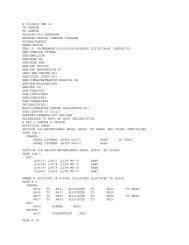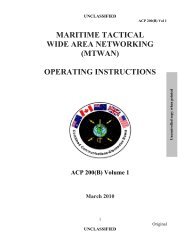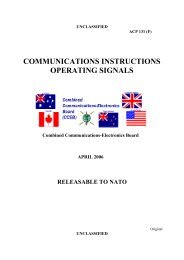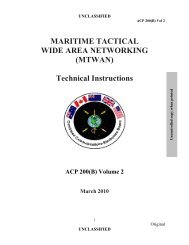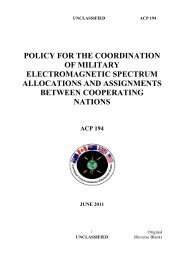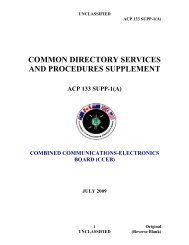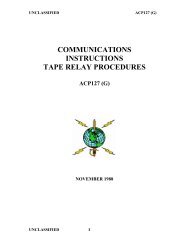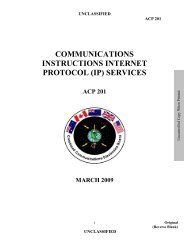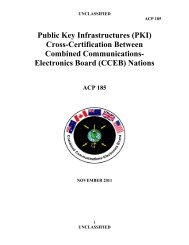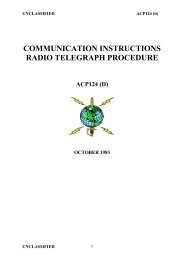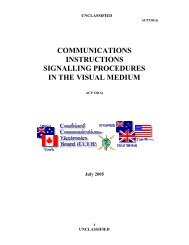ground routing protocol for use with automatic link establishment
ground routing protocol for use with automatic link establishment
ground routing protocol for use with automatic link establishment
You also want an ePaper? Increase the reach of your titles
YUMPU automatically turns print PDFs into web optimized ePapers that Google loves.
UNCLASSIFIED<br />
ACP193<br />
(2) CCCCDP904563895NNNN<br />
(b) Programmed dial call. The example message (3) specifies a call to ‘AB1’. The code<br />
‘AB1’ will be translated to a <strong>routing</strong> dial number via a lookup table at the receiving HF<br />
<strong>ground</strong> station.<br />
(3) CCCCPAB1NNNN<br />
(c) Programmed dial call – Hybrid version. The example message (4) specifies a call to<br />
‘904563472’ preceded by the additional dial digits held at the ‘AB2’ lookup table position<br />
stored at the receiving HF <strong>ground</strong> station. E.g. if the ‘AB2’ lookup table position held ‘0044’<br />
then the full code dialled by the receiving HF <strong>ground</strong> station would be ‘0044904563472’.<br />
(4) CCCCPAB2904563472NNNN<br />
(d) Self-verified direct dial call. The first example message (5) specifies a ‘Routine call’<br />
to ‘904563472’. The call verification character ‘9’ will be <strong>use</strong>d to check <strong>for</strong> character errors<br />
after reception at the HF <strong>ground</strong> station. The second example message (6) specifies a ‘Priority<br />
call’ to ‘904563895’. The call verification character ‘7’ will be <strong>use</strong>d to check <strong>for</strong> character<br />
errors after reception at the HF <strong>ground</strong> station.<br />
(5) CCCCW9045634729NNNN<br />
(6) CCCCWP9045638957NNNN<br />
(e) Self-verified programmed dial call. The example message (7) specifies a call to<br />
‘UKSIG2’. The call verification character ‘3’ will be <strong>use</strong>d to check <strong>for</strong> character errors after<br />
reception at the HF <strong>ground</strong> station. The code ‘UKSIG2’ will be translated to a <strong>routing</strong> dial<br />
number via a lookup table at the receiving HF <strong>ground</strong> station.<br />
(7) CCCCVUKSIG23NNNN<br />
(f) Self-verified Programmed dial call – Hybrid version. The example message (8)<br />
specifies a call to ‘8017842’ preceded by the additional digits held at the ‘UK2’ lookup table<br />
position stored at the receiving HF <strong>ground</strong> station. For example, if the ‘UK2’ lookup table<br />
position held ‘123’ then the full code dialled by the receiving HF <strong>ground</strong> station would be<br />
‘1238017842’. The call verification character ‘E’ will be <strong>use</strong>d to check <strong>for</strong> character errors<br />
after reception at the HF <strong>ground</strong> station. Inclusion of the ‘,’ (comma) character in field 4<br />
specifies a two second pa<strong>use</strong> in the dialling between the ‘8’ and the remaining digits.<br />
(8) CCCCVUK28,017842ENNNN<br />
203. Call Precedence<br />
(a) The urgency associated <strong>with</strong> a call, is attributed by the <strong>use</strong>r using the ‘Call<br />
Precedence’ (field 3) indicator <strong>with</strong>in the HF-GRP message. The order of precedence is<br />
defined as follows.<br />
2-5<br />
UNCLASSIFIED



